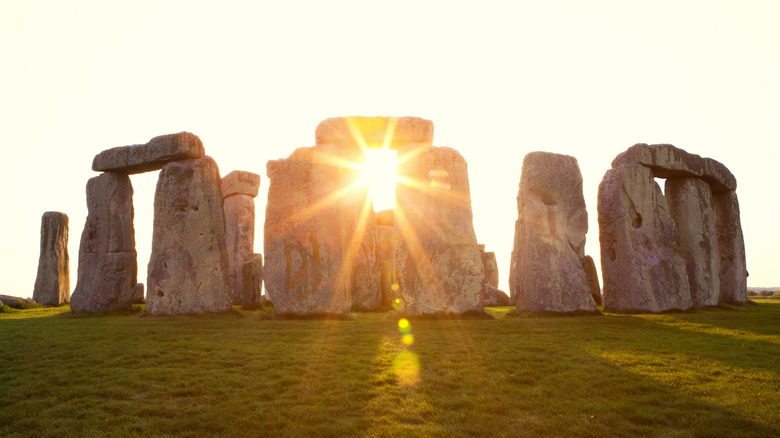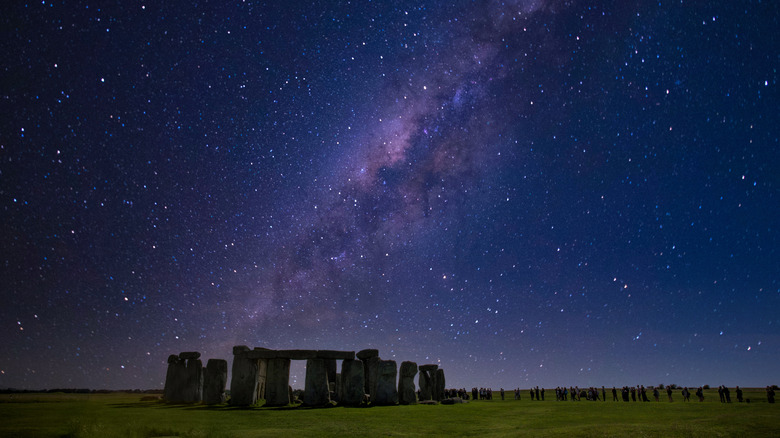Why People Flock To Stonehenge During The Winter Solstice
Stonehenge holds a singular, mystical status in the minds of the U.K. public and around the world. No doubt the mystique surrounding Stonehenge — located in Salisbury, England about 2 hours by train southwest of London — stems from all the unanswered questions about the monolithic stone monument. Who built it? Why was it built? How was it built? Sites like English Heritage overview the likely construction of Stonehenge, down to the use of 25-ton sarsen stones that originated 20 miles away and the building of ditches and enclosures of earth at the site. And while researchers have chipped away at Stonehenge's mysteries since its first discovery back in 1620, many answers remain unknown.
The British Museum outlines the evolution of Stonehenge over time, from its likely very first wooden poles erected in 7000 B.C.E. to the first stones arriving a whopping 4,000 years later. People were buried at the site from 1900 to 1650 B.C.E., and starting in 1500 B.C.E. the site seemingly started to fall out of use. Stonehenge's peak period fell between 2,500 and 2,000 years ago, when it served a function crucial to the lives and survival of the people at the time: a solar calendar. Most critically, it was apparently used to track the sun to and from the winter solstice on December 21 or 22 in the northern hemisphere — the darkest day of the year that heralds more light to come. And today? Many people still flock to Stonehenge for this same purpose.
Celebrating the rebirth of the sun
At this point in history lots of folks might not remember when the winter solstice occurs, or even know what it is. But for our ancestors who were reliant on the turning of the seasons for the planting and harvesting of food, the reproductive cycles of animals, weather and light patterns, etc., the longest night of the year represented not sadness, but hope. Starting on December 21 or 22, sunlight in the northern hemisphere grows day by day till we hit the summer solstice six months later on June 20 or 21. In fact, midwinter celebrations — commonly called Yule — were once common across pre-Christian Western European cultures, as Big Think describes.
Following the lifting of COVID-19 lockdowns, 2022 saw the largest recorded amount of people gathered at Stonehenge to celebrate the winter solstice, as The Guardian shows above. In fact, the BBC counted about 4,500 people onsite that year and another 100,000 watching online through livestreams like English Heritage's via YouTube. There was singing, music, dancing, costumes, and religious ceremonies with casual attendees and serious pagan believers alike. As the BBC cites, the winter solstice represents the "re-birth" of the sun moving into months containing the daylight and warmer temperatures of spring. "This is our new year, we don't celebrate on the first of January," the BBC quotes Stonehenge-goer Richard Parker, who continued, "It's a fantastic atmosphere and you can really let yourself go and be one with everyone."
Ancient calendar and tourist hotspot
Sci News goes into detail about Stonehenge's construction. On the summer solstice, the sun rises at Stonehenge's northeast, and on the winter solstice it sets at the southwest. The entire henge is divided into three "decans," or subdivisions, along a "principal axis" that cuts through the monument's center along the northeast to southwest line. Stonehenge contains 30 stones for 30 calendar days, based upon our familiar calendar of 365.25 days (including one leap year every four years). As for the extent of its builders' astronomical knowledge and who they were — we don't know and possibly never will (though we do know it wasn't druids, aliens, or wizards who floated the rocks into place).
At present, anyone can go to Stonehenge on the winter solstice — and any other day of the year. You can book tickets ahead of time through sites like English Heritage or do a package tour through sites like Stonehenge Tours, Solstice Tours, Stonehenge London Tours, and many more. Those seeking to visit on the winter solstice can arrive at the car park as early as 5:15 a.m., and enter the monument grounds from 7:45 a.m., per English Heritage. During this most important time of the year admission is free. The number one rule is simply "respect the stones." As English Heritage says, "Stonehenge is a significant World Heritage Site and to many it is sacred — please respect the stones and all those who are attending."

